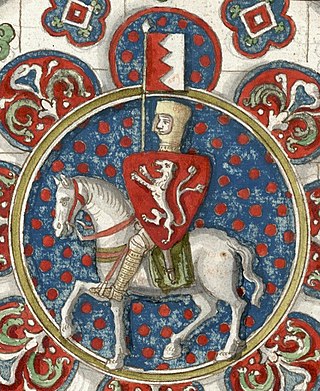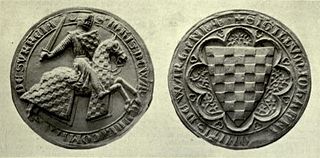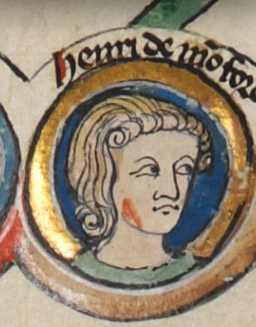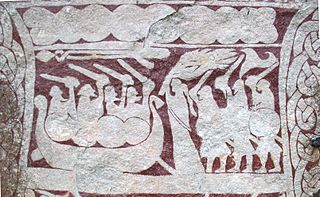
Simon de Montfort, 6th Earl of Leicester, later sometimes referred to as Simon V de Montfort to distinguish him from his namesake relatives, was an English nobleman of French origin and a member of the English peerage, who led the baronial opposition to the rule of King Henry III of England, culminating in the Second Barons' War. Following his initial victories over royal forces, he became de facto ruler of the country, and played a major role in the constitutional development of England.

Bethnal Green was a civil parish and a metropolitan borough of the County of London between 1899 and 1965, when it was merged with the Metropolitan Borough of Stepney and the Metropolitan Borough of Poplar to form the London Borough of Tower Hamlets.

The title of Earl of Northumberland has been created several times in the Peerage of England and of Great Britain, succeeding the title Earl of Northumbria. Its most famous holders are the House of Percy, who were the most powerful noble family in Northern England for much of the Middle Ages. The heirs of the Percys, via a female line, were ultimately made Duke of Northumberland in 1766, and continue to hold the earldom as a subsidiary title.

John de Warenne, 6th Earl of Surrey was a prominent English nobleman and military commander during the reigns of Henry III of England and Edward I of England. During the Second Barons' War he switched sides twice, ending up in support of the king, for whose capture he was present at Lewes in 1264. Warenne was later appointed as "warden of the kingdom and land of Scotland" and featured prominently in Edward I's wars in Scotland.

Sir Henry de Montfort was the son of Simon de Montfort, 6th Earl of Leicester, and with his father played an important role in the struggle of the barons against King Henry III. Henry's mother was Princess Eleanor of England, a daughter of King John, whose marriage to Simon further increased the foreign influence begun by the king, which was to result in great hostility by those very barons who later revolted against the king.

Thomas Percy was Bishop of Dromore, County Down, Ireland. Before being made bishop, he was chaplain to George III of the United Kingdom. Percy's greatest contribution is considered to be his Reliques of Ancient English Poetry (1765), the first of the great ballad collections, which was the one work most responsible for the ballad revival in English poetry that was a significant part of the Romantic movement.

The Blind Beggar is a pub in Whitechapel Road in the East End of London, England, at the junction with Cambridge Heath Road.

Amaury de Montfort was the third son of parliamentary pioneer Simon de Montfort, 6th Earl of Leicester, and Eleanor of England, daughter of King John.

Hjaðningavíg, the legend of Heðinn and Hǫgni or the Saga of Hild is a Germanic heroic legend about a never-ending battle which is documented in Sörla þáttr, Ragnarsdrápa, Gesta Danorum, Skíðaríma and in Skáldskaparmál. It is also held to appear on the image stone at Stora Hammar on Gotland. Moreover, it is alluded to in the Old English poems Deor and Widsið, and in the Old Norse Háttalykill inn forni, and a version of it survived down to the 18th century in the traditional Norn language ballad "Hildina". An altered version of the saga is found in the Middle High German poem Kudrun, as a prologue to the story of Kudrun herself. Yet another version is found in the Old Yiddish Dukus Horant.

"The King and the Beggar-maid" is a 16th-century broadside ballad that tells of an African king, Cophetua, and his love for the beggar Penelophon. Artists and writers have referenced the story, and King Cophetua has become a byword for "a man who falls in love with a woman instantly and proposes marriage immediately".
Catskin is an English fairy tale collected by Joseph Jacobs in More English Fairy Tales. Marian Roalfe Cox, in her study of Cinderella, identified as one of the basic types, the Unnatural Father, contrasting with Cinderella itself and Cap O' Rushes.
"Lady Isabel and the Elf Knight" is the English common name representative of a very large class of European ballads.

"The Two Sisters" is a traditional murder ballad, dating at least as far back as the mid 17th century. The song recounts the tale of a girl drowned by her jealous sister. At least 21 English variants exist under several names, including "Minnorie" or "Binnorie", "The Cruel Sister", "The Wind and Rain", "Dreadful Wind and Rain", "The Bonny Swans" and the "Bonnie Bows of London". The ballad was collected by renowned folklorist Francis J. Child as Child Ballad 10 and is also listed in the Roud Folk Song Index. Whilst the song is thought to originate somewhere around England or Scotland, extremely similar songs have been found throughout Europe, particularly in Scandinavia.

"Hind Horn" is a traditional English and Scottish folk ballad.
The Knight's Ghost is a traditional English-language folk ballad. It tells the story of a woman who learns that her husband has died in battle, after which she locks his men in a cellar and throws the keys in the sea. Her husband's ghost appears to ask that she release his men, assuring her they fought bravely. Francis Child drew the ballad from Buchan's Ballads of the North of Scotland.
King Arthur and King Cornwall is an English ballad surviving in fragmentary form in the 17th-century Percy Folio manuscript. An Arthurian story, it was collected by Francis James Child as Child Ballad 30. Unlike other Child Ballads, but like the Arthurian "The Boy and the Mantle" and "The Marriage of Sir Gawain", it is not a folk ballad but a professional minstrel's song. It is notable for containing the Green Knight, a character known from the medieval poems The Greene Knight and the more famous Sir Gawain and the Green Knight; he appears as "Bredbeddle", the character's name in The Greene Knight.
"The Lochmaben Harper" or "The Blind Harper" is a traditional British Folk ballad and is one of the ballads collected by Francis Child in The English and Scottish Popular Ballads (1882–1898).
Alice de Lusignan was the first wife of Marcher baron Gilbert de Clare, 7th Earl of Gloucester, and half-niece of King Henry III of England.

The Odyssey is an eight-episode European TV miniseries broadcast on RAI in 1968 and based on Homer's Odyssey. An Italian, Yugoslavian, German and French coproduction, it was directed by Franco Rossi, assisted by Piero Schivazappa and Mario Bava; the cast includes Bekim Fehmiu as Odysseus and Irene Papas as Penelope, Samson Burke as the Cyclops, as well as Barbara Bach as Nausicaa, and Gérard Herter. Several critics consider the series to be a masterful representation of the ancient world.

Blind Beggar and his Dog is a bronze statue of 1958, by the sculptor Elisabeth Frink, based on the famous ballad The Blind Beggar of Bethnal Green. It stands in the enclosed garden of Tate House, a residential development for the elderly on the Cranbrook Estate in the London district of Bethnal Green. It is a Grade II* listed structure.














